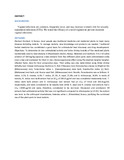Brine shrimp cytotoxicity and antimalarial activity of plants traditionally used in treatment of malaria in Msambweni district.

View/
Date
2014Author
Mwangi, GG
Wagacha, JM
Nguta, JM
Mbaria, JM.
Language
enMetadata
Show full item recordAbstract
Abstract Context: In Kenya, most people use traditional medicine and medicinal plants to treat many diseases including malaria. To manage malaria, new knowledge and products are needed. Traditional herbal medicine has constituted a good basis for antimalarial lead discovery and drug development. Objectives: To determine in vivo antimalarial activity and brine shrimp toxicity of five medicinal plants traditionally used to treat malaria in Msambweni district, Kenya. Materials and methods: A 0.2 ml saline solution of 100 mg/kg aqueous crude extracts from five different plant parts were administered orally once a day and evaluated for their in vivo chemosuppressive effect using Plasmodium berghei berghei-infected Swiss mice for four consecutive days. Their safety was also determined using Brine shrimp lethality test: Grewia trichocarpa Hochst ex A. Rich (Tiliaceae) root, Dicrostachys cinerea (L) Wight et Am (Mimosaceae) root, Tamarindus indica L. (Caesalpiniaceae) stem bark, Azadirachta indica (L) Burn. (Meliaceae) root bark, and Acacia seyal Del. (Mimosaceae) root. Results: Parasitaemia was as follows: A. indica, 3.1%; D. cinerea, 6.3%; T. indica, 25.1%; A. seyal, 27.8%; and G. trichocarpa, 35.8%. In terms of toxicity, A. indica root bark extract had an LC50 of 285.8 µg/ml and was considered moderately toxic. T. indica stem bark extract and G. trichocarpa root extract had an LC50 of 516.4 and 545.8 µg/ml, respectively, and were considered to be weakly toxic while A. seyal and D. cinerea root extracts had a LC50 >1000 µg/ml and were, therefore, considered to be non-toxic. Discussion and conclusion: All extracts had antimalarial activity that was not significant compared to chloroquine (p ≥ 0.05). No extract was toxic to the arthropod invertebrate, Artemia salina L. (Artemiidae) larvae, justifying the continued use of the plant parts to treat malaria.
Citation
Pharm Biol. 2014 Dec 11:1-6.Publisher
University of Nairobi
